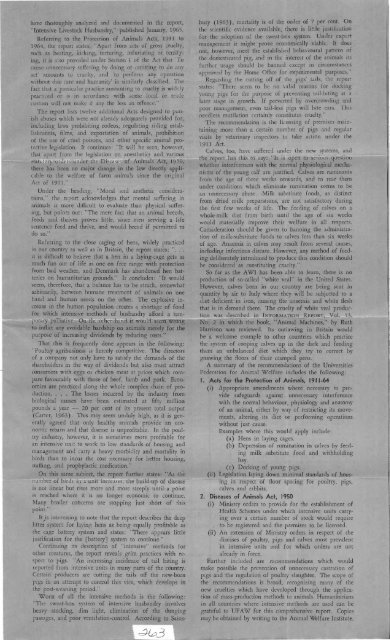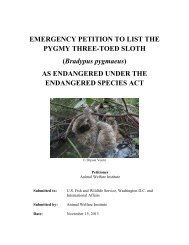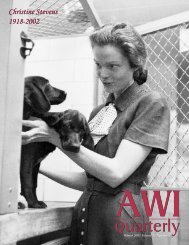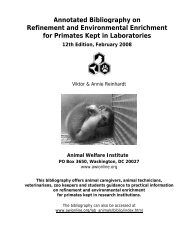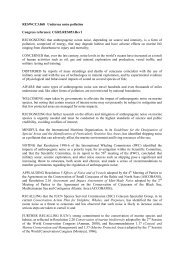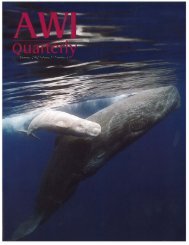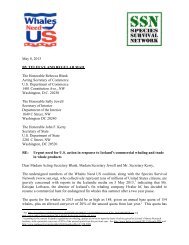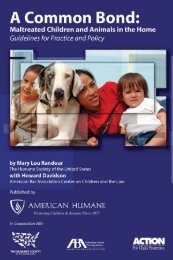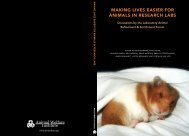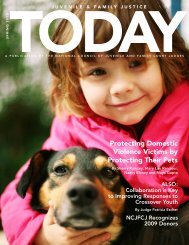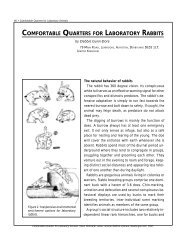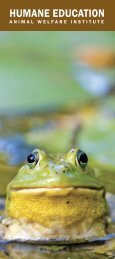AT ION - Animal Welfare Institute
AT ION - Animal Welfare Institute
AT ION - Animal Welfare Institute
You also want an ePaper? Increase the reach of your titles
YUMPU automatically turns print PDFs into web optimized ePapers that Google loves.
a3<br />
have thoroughly analyzed and documented in the report,<br />
"Intensive Livestock Husbandry," published January, 1965.<br />
Referring to the Protection of <strong>Animal</strong>s Acts, 1911 to<br />
1964, the report states, "Apart from acts of gross cruelty,<br />
such as beating, kicking, torturing, infuriating or terrifying,<br />
it is also provided under Section 1 of the Act that To<br />
cause unnecessary suffering by doing or omitting to do any<br />
act' amounts to cruelty, and 'to perform any operation<br />
without due care and humanity' is similarly classified. The<br />
fact that a particular practice amounting to cruelty is widely<br />
practiced or is in accordance with some local or trade<br />
custom will not make it any the less an offence."<br />
The report lists twelve additional Acts designed to punish<br />
abuses which were not already adequately provided for,<br />
including laws prohibiting rodeos, regulating riding establishments,<br />
films, and exportation of animals, prohibition<br />
of the use of cruel poisons, and other specific animal protective<br />
legislation. It continues: "It will be seen, however,<br />
that apart from the legislation on anesthetics and various<br />
statutory orders under the Diseases of <strong>Animal</strong>s Act, 1950,<br />
there has been no major change in the law directly applicable<br />
to the welfare of farm animals since the original<br />
Act of 1911."<br />
Under the heading, "Moral and aesthetic considerations,"<br />
the report acknowledges that mental suffering in<br />
animals is more difficult to evaluate than physical suffering,<br />
but points out: "The mere fact that an animal breeds,<br />
feeds and thrives proves little, since men serving a life<br />
sentence feed and thrive, and would breed if permitted to<br />
do so."<br />
Referring to the close caging of hens, widely practiced<br />
in our country as well as in Britain, the report states: ". . .<br />
it is difficult to believe that a hen in a laying-cage gets as<br />
much fun out of life as one on free range with protection<br />
from bad weather, and Denmark has abandoned hen batteries<br />
on humanitarian grounds." It concludes: "It would<br />
seem, therefore, that a balance has to be struck, somewhat<br />
arbitrarily, between humane treatment of animals on one<br />
hand and human needs on the other. The explosive increase<br />
in the human population creates a shortage of food<br />
for which intensive methods of husbandry afford a temporary<br />
palliative. On the other hand it would seem wrong<br />
to inflict any avoidable hardship on animals merely for the<br />
purpose of increasing dividends by reducing costs."<br />
That this is frequently done appears in the following:<br />
"Poultry agribusiness is fiercely competitive. The directors<br />
of a company not only have to satisfy the demands of the<br />
shareholders in the way of dividends but also must attract<br />
consumers with eggs or chicken meat at prices which compare<br />
favourably with those of beef, lamb and pork. Economies<br />
are practiced along the whole complex chain of production.<br />
. . . The losses incurred by the industry from<br />
biological causes have been estimated at fifty million<br />
pounds a year — 20 per cent of its present total output<br />
(Carter, 1963). This may seem unduly high, as it is generally<br />
agreed that only healthy animals provide an economic<br />
return and that disease is unprofitable. In the poultry<br />
industry, however, it is sometimes more profitable for<br />
an intensive unit to work to low standards of housing and<br />
management and carry a heavy morbidity and mortality in<br />
birds than to incur the cost necessary for better housing,<br />
staffing, and prophylactic medication."<br />
On this same subject, the report further states: "As the<br />
number of birds in a unit increases, the build-up of disease<br />
is not linear but rises more and more steeply until a point<br />
is reached where it is no longer economic to continue.<br />
Many broiler concerns are stopping just short of this<br />
point."<br />
It,is interesting to note that the report describes the deep<br />
litter system for laying hens as being equally profitable as<br />
the cage battery system and states: "There appears little<br />
justification for the [battery) system to continue."<br />
Continuing its description of "intensive" methods for<br />
other creatures, the report reveals grim practices with respect<br />
to pigs. "An increasing incidence of tail biting is<br />
reported from intensive units in many parts of the country.<br />
Certain producers are cutting the tails off the new-born<br />
pigs in an attempt to control this vice, which develops in<br />
the post-weaning period."<br />
Worst of all the intensive methods is the following:<br />
"The sweat-box system of intensive husbandry involves<br />
heavy stocking, dim light, elimination of the dunging<br />
passages, and poor ventilation-control. According to Sainsbury<br />
(1963), mortality is of the order of 7 per cent. On<br />
the scientific evidence available, there is little justification<br />
for the adoption of the sweat-box system. Under expert<br />
management it might prove economically viable. It does<br />
not, however, meet the established behavioural pattern of<br />
the domesticated pig, and in the interest of the animals its<br />
further usage should be banned except in circumstances<br />
approved by the Home Office for experimental purposes."<br />
Regarding the cutting off of the pigs' tails, the report<br />
states: "There seem to be no valid reasons for docking<br />
young pigs for the purpose of preventing tail-biting at a<br />
later stage in growth. If perverted by overcrowding and<br />
poor management, even tail-less pigs will bite ears. This<br />
needless mutilation certainly constitutes cruelty."<br />
The recommendation is the licensing of premises maintaining<br />
more than a certain number of pigs and regular<br />
visits by veterinary inspectors to take action under the<br />
1911 Act.<br />
Calves, too, have suffered under the new systems, and<br />
the report has this to say: "It is open to serious question<br />
whether interferences with the normal physiological mechanisms<br />
of the young calf are justified. Calves are ruminants<br />
from the age of three weeks onwards, and to rear them<br />
under conditions which eliminate rumination seems to be<br />
an unnecessary abuse. Milk substitute foods, as distinct<br />
from dried milk preparations, are not satisfactory during<br />
the first few weeks of life. The feeding of calves on a<br />
whole-milk diet from birth until the age of six weeks<br />
would materially improve their welfare in all respects.<br />
Consideration should be given to banning the administration<br />
of milk-substitute foods to calves less than six weeks<br />
of age. Anaemia in calves may result from several causes,<br />
including infectious disease. However, any method of feeding<br />
deliberately introduced to produce this condition should<br />
be considered as constituting cruelty."<br />
So far as the AWI has been able to learn, there is no<br />
production of so-called "white veal" in the United States.<br />
However, calves born in our country are being sent in<br />
quantity by air to Italy where they will be subjected to a<br />
diet deficient in iron, causing the anaemia and white flesh<br />
that is in demand there. The cruelty of white veal production<br />
was described in INFORM<strong>AT</strong><strong>ION</strong> REPORT, Vol. 13,<br />
No. 2 in which the book, "<strong>Animal</strong> Machines," by Ruth<br />
Harrison was reviewed. Its outlawing in Britain would<br />
be a welcome example to other countries which practice<br />
the system of cooping calves up in the dark and feeding<br />
them an unbalanced diet which they try to correct by<br />
gnawing the floors of their cramped pens.<br />
A summary of the recommendations of the Universities<br />
Federation for <strong>Animal</strong> <strong>Welfare</strong> includes the following:<br />
I. Acts for the Protection of <strong>Animal</strong>s, 1911 -64<br />
(i) Appropriate amendments where necessary to provide<br />
safeguards against unnecessary interference<br />
with the normal behaviour, physiology and anatomy<br />
of an animal, either by way of restricting its movements,<br />
altering its diet or performing operations<br />
without just cause.<br />
Examples where this would apply include:<br />
(a)<br />
(b)<br />
Hens in laying cages.<br />
Depression of rumination in calves by feeding<br />
milk substitute food and withholding<br />
hay.<br />
(c) Docking of young pigs.<br />
(ii) Legislation laying down minimal standards of housing<br />
in respect of floor spacing for poultry, pigs,<br />
calves and rabbits.<br />
2. Diseases of <strong>Animal</strong>s Act, 1950<br />
(i) Ministry orders to provide for the establishment of<br />
Health Schemes under which intensive units carrying<br />
over a certain number of stock would require<br />
to be registered and the premises to be licensed.<br />
(ii) An extension of Ministry orders in respect of the<br />
diseases of poultry, pigs and calves most prevalent<br />
in intensive units and for which orders are not<br />
already in force.<br />
Further included are recommendations which would<br />
make possible the prevention of unnecessary castration of<br />
pigs and the regulation of poultry slaughter. The scope of<br />
the recommendations is broad, recognizing many of the<br />
new cruelties which have developed through the application<br />
of mass-production methods to animals. Humanitarians<br />
in all countries where intensive methods are used can be<br />
grateful to UFAW for this comprehensive report. Copies<br />
may be obtained by writing to the <strong>Animal</strong> <strong>Welfare</strong> <strong>Institute</strong>.


